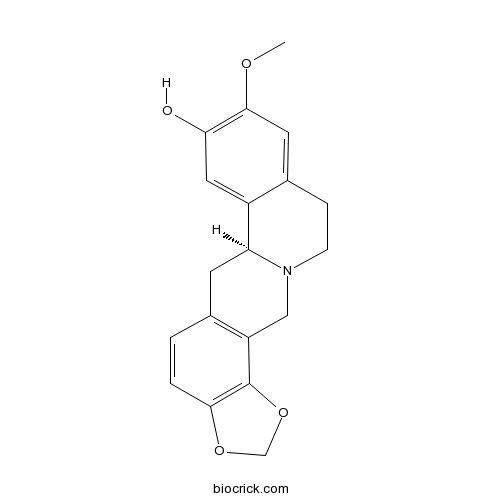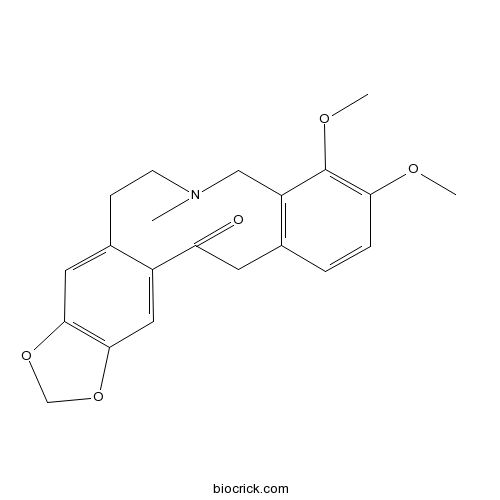Corydalis saxicola
Corydalis saxicola
1. The products in our compound library are selected from thousands of unique natural products; 2. It has the characteristics of diverse structure, diverse sources and wide coverage of activities; 3. Provide information on the activity of products from major journals, patents and research reports around the world, providing theoretical direction and research basis for further research and screening; 4. Free combination according to the type, source, target and disease of natural product; 5. The compound powder is placed in a covered tube and then discharged into a 10 x 10 cryostat; 6. Transport in ice pack or dry ice pack. Please store it at -20 °C as soon as possible after receiving the product, and use it as soon as possible after opening.
Natural products/compounds from Corydalis saxicola
- Cat.No. Product Name CAS Number COA
-
BCN5528
Betulin473-98-3
Instructions

-
BCN7827
Cheilanthifoline483-44-3
Instructions

-
BCN9043
Allocryptopine485-91-6
Instructions

Inhibitory and inductive effects of Corydalis saxicola Bunting total alkaloids (CSBTA) on cytochrome P450s in rats.[Pubmed: 29806105]
None
Antitumor lignanamides from the aerial parts of Corydalis saxicola.[Pubmed: 27823624]
Cancer is one of the leading cause of unnatural death globally. There is still a great need for effective anticancer agents from plant sources. Corydalis saxicola Bunting is a medicinal plant that is traditionally used to treat various diseases in southwest China. Previous phytochemical investigations of C. saxicola have focused on isoquinoline alkaloids that have been isolated, which have activity against anti-hepatitis B virus and inhibit DNA topoisomerase I. However, the exploration of other classes of constituents and their bioactivities needs further study.
Serum metabonomics study of the hepatoprotective effect of Corydalis saxicola Bunting on carbon tetrachloride-induced acute hepatotoxicity in rats by (1)H NMR analysis.[Pubmed: 27399344]
Corydalis saxicola Bunting (CS), a traditional Chinese folk medicine, has been effectively used for treating liver disease in Zhuang nationality in South China. However, the exact hepatoprotective mechanism of CS was still looking forward to further elucidation by far. In present work, metabonomic study of biochemical changes in the serum of carbon tetrachloride (CCl4)-induced acute liver injury rats after CS treatment were performed using proton nuclear magnetic resonance ((1)H-NMR) analysis. Metabolic profiling by means of principal components analysis (PCA) and partial least squares-discriminate analysis (PLS-DA) indicated that the metabolic perturbation caused by CCl4 was reduced by CS treatment. A total of 9 metabolites including isoleucine (1), lactate (2), alanine (3), glutamine (4), acetone (5), succinate (6), phosphocholine (7), d-glucose (8) and glycerol (9) were considered as potential biomarkers involved in the development of CCl4-induced acute liver injury. According to pathway analysis by metabolites identified and correlation network construction by Pearson's correlation coefficency matrix, alanine, aspartate and glutamate metabolism and glycerolipid metabolism were recognized as the most influenced metabolic pathways associated with CCl4 injury. As a result, notably, deviations of metabolites 1, 3, 4, 7 and 9 in the process of CCl4-induced acute liver injury were improved by CS treatment, which suggested that CS mediated synergistically abnormalities of the metabolic pathways, composed of alanine, aspartate and glutamate metabolism and glycerolipid metabolism. In this study, it was the first report to investigate the hepatoprotective effect of the CS based on metabonomics strategy, which may be a potentially powerful tool to interpret the action mechanism of traditional Chinese folk medicines.
[Study on effect of oligochitosan in promoting intestinal absorption of protoberberine alkaloids in extracts from Corydalis saxicola total alkaloids].[Pubmed: 26323154]
To investigate the effect of oligochitosan in promoting intestinal absorption of protoberberine alkaloids in extracts from Corydalis saxicola total alkaloids.
Anti-hepatitis B virus effects of dehydrocheilanthifoline from Corydalis saxicola.[Pubmed: 23336511]
In this report, the anti-hepatitis B virus (HBV) activity of dehydrocheilanthifoline (DHCH), a quaternary ammonium alkaloid isolated from the traditional Chinese medicine Corydalis saxicola Bunting (Papaveraceae), was determined in vitro. Following six days of treatment, DHCH efficiently suppressed the secretions of HBsAg and HBeAg in HepG2.2.15 cell cultures, with a half-maximal inhibitory concentration (IC(50)) of 15.84 and 17.12 μM, and with a therapeutic index (TI) of 7.32 and 6.77, respectively. Further studies revealed that DHCH reduced the levels of extracellular DNA, intracellular DNA and covalently closed circular DNA (cccDNA) of HBV in a dose-dependent and time-dependent manner, with IC(50) values of 15.08, 7.62 and 8.25 μM, respectively after six days of treatment. In contrast, the level of viral pre-genomic RNA (pgRNA) increased 6.13-fold after treatment with DHCH. Together, it was demonstrated for the first time that DHCH could significantly inhibit the replication of HBV, which warrants further studies on the antiviral mechanisms of DHCH, and suggests that it may be a promising candidate in the therapy of HBV infection.


